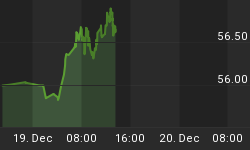Below is a snippet from the latest weekly issue from www.GoldForecaster.com | www.SilverForecaster.com
F.O.M.C. - The prospects for the U.S. interest rates and the $.
The Fed's Open Market Committee yesterday repeated its assessment from March 21st that persistent inflation remains the predominant policy concern. Interest rates were held at 5.25%. The Fed has just said, "inflation is a predominant risk" but did not raise interest rates, and indicated that it is not likely to do so, as it pointed to lower growth and the ongoing housing price problems.
The impression given is that it will react to higher inflation but will not pre-empt it. The dangers of inflation with falling growth [stagflation] are now apparent. This is gold positive and $ negative as the Trade deficit will continue at excessive levels in a climate that could discourage the investment of surplus $ [Asian nations in particular] back into the States.
Caught between lower growth and inflation, the Fed is caught between a rock and a hard place and unlikely to move rates until one overrides the other completely. We have said over a very long period that the Fed must guard against falling growth even if inflation takes off. Growth is extremely difficult to engender, whereas inflation is manageable, without damaging jobs.
The FOMC reiterated that "the committee's predominant policy concern remains the risk that inflation will fail to moderate as expected.' However, the economy is still likely to grow at a moderate pace in coming quarters. We at the Gold Forecaster would suggest that a very firm eye be kept on growth figures for if it seems that growth will slide, be sure that inflation fighting will retreat to sitting in the trenches and stimulation will lead the charge. We believe it would be a mistake to think that the Fed will raise rates to attack inflation, if there is the slightest risk that growth will be damaged.
The U.S. economy expanded at a 1.3% annual rate last quarter, handicapped by a 17% slide in residential investment, the sixth quarterly decline. At the same time, unemployment was 4.5% last month, close to a five-year low. With falling growth all eyes are on the way forward. Is it to stagflation, or inflation, on the back of sound growth? The answer to this will dictate the way forward for the $. Consequently, Investors have postponed their expectations for a rate cut to the final three months of the year, from the third quarter immediately following the March meeting. Two-year note yields rose 6 basis points yesterday, to 4.73%.
The Trade deficit.
Rising to $63.9 billion the Trade deficit continues at $ undermining levels and should continue to do so for the foreseeable future. As Paulson advocates a strong $ at market rates [a contradiction in terms?] the $ showed initial strength rising above the danger zone between $1.35 - $1.37. Media attention concentrated on it rising above last month's level and not on the amazing accumulation of the deficit over the year, on top of previous years.
To emphasize what we are saying, imagine it were twice the present level, a level to cause global $ indigestion, what would be the consequences? Clearly, a tumbling $. So the reality is that the deficit will continue at these levels in the future, so for it to go on for twice as long, would result in the same damage to the $. In other words, at some point in the future the deficit just will not be accepted and the $ will crash.
Imagine now a bank's customer loaned persistently from the bank with no hope of repaying the debt, what would happen? Now imagine this customer is the only client of that bank or several banks, what would happen? Quite frankly it is in the interests of all parties to ensure that the myth of a steady $ exchange rate [held there by intervention by surplus holders] will be blown away someday.
Until then so long as it can be translated into goods at present values it serves surplus holders to keep its value up and does not serve the U.S. government, as jobs and capital ownership shifts eastwards. Perhaps the sapping of the U.S.' global economic strength is deemed unavoidable and the authorities are making sure that the weakening is done without pain, as no other solution is available?
Validating our belief that a growing U.S. economy sucks in imports, during March, imports and exports rebounded to their second-highest levels on record, but imports rose faster than exports. Imports of goods alone rose 5.1% to $160.3 billion in March. In addition to oil, the U.S. imported more autos, consumer goods, and food. Exports of goods alone rose 2.0% to $90.2 billion. U.S. exports of industrial supplies, autos and consumer goods rose in March. Of course the higher oil price had a significant impact on the Balance of Payments, as the petroleum deficit widened 2.6% to $45.5 billion, the largest deficit since last September. The U.S. imported 324.2 million barrels of crude oil in March, or 10.5 million barrels per day, marking the highest level since last August. These figures compared with 252.9 million barrels, or 9.0 million barrels, respectively, in February. The average price per barrel of oil rose to $53 in March, its highest level since December. With the oil price rising through, to over, $60 a barrel, expect next month's Trade deficit to widen accordingly.
So the prognosis on the Trade front is not good and the $ should reflect this. We believe intervention is currently preventing this, but against strong flows of 'carry trade' investments and the investment of surplus $' back into the States.
This leave the question begging, "Just how long will the U.S. or anyone else, allow this?"
![]()
Please subscribe to: www.GoldForecaster.com for the entire report.















